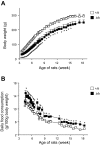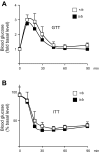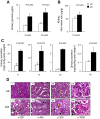Glucose metabolism in the Belgrade rat, a model of iron-loading anemia
- PMID: 23599042
- PMCID: PMC3680718
- DOI: 10.1152/ajpgi.00453.2012
Glucose metabolism in the Belgrade rat, a model of iron-loading anemia
Abstract
The iron-diabetes hypothesis proposes an association between iron overload and glucose metabolism that is supported by a number of epidemiological studies. The prevalence of type 2 diabetes in patients with hereditary hemochromatosis and iron-loading thalassemia supports this hypothesis. The Belgrade rat carries a mutation in the iron transporter divalent metal transporter 1 (DMT1) resulting in iron-loading anemia. In this study, we characterized the glycometabolic status of the Belgrade rat. Belgrade rats displayed normal glycemic control. Insulin signaling and secretion were not impaired, and pancreatic tissue did not incur damage despite high levels of nonheme iron. These findings suggest that loss of DMT1 protects against oxidative damage to the pancreas and helps to maintain insulin sensitivity despite iron overload. Belgrade rats had lower body weight but increased food consumption compared with heterozygous littermates. The unexpected energy balance was associated with increased urinary glucose output. Increased urinary excretion of electrolytes, including iron, was also observed. Histopathological evidence suggests that altered renal function is secondary to changes in kidney morphology, including glomerulosclerosis. Thus, loss of DMT1 appears to protect the pancreas from injury but damages the integrity of kidney structure and function.
Keywords: iron overload; kidney.
Figures






Similar articles
-
Impaired renal function and development in Belgrade rats.Am J Physiol Renal Physiol. 2014 Feb 1;306(3):F333-43. doi: 10.1152/ajprenal.00285.2013. Epub 2013 Nov 13. Am J Physiol Renal Physiol. 2014. PMID: 24226520 Free PMC article.
-
Iron handling and gene expression of the divalent metal transporter, DMT1, in the kidney of the anemic Belgrade (b) rat.Kidney Int. 2003 Nov;64(5):1755-64. doi: 10.1046/j.1523-1755.2003.00274.x. Kidney Int. 2003. PMID: 14531808
-
Loss of divalent metal transporter 1 function promotes brain copper accumulation and increases impulsivity.J Neurochem. 2016 Sep;138(6):918-28. doi: 10.1111/jnc.13717. Epub 2016 Jul 22. J Neurochem. 2016. PMID: 27331785 Free PMC article.
-
H(+)-coupled divalent metal-ion transporter-1: functional properties, physiological roles and therapeutics.Curr Top Membr. 2012;70:169-214. doi: 10.1016/B978-0-12-394316-3.00005-3. Curr Top Membr. 2012. PMID: 23177986 Free PMC article. Review.
-
Divalent metal transporter 1.Hematology. 2005 Aug;10(4):339-45. doi: 10.1080/10245330500093419. Hematology. 2005. PMID: 16085548 Review.
Cited by
-
Tetramethylpyrazine nitrone activates hypoxia-inducible factor and regulates iron homeostasis to improve renal anemia.Front Pharmacol. 2022 Oct 17;13:964234. doi: 10.3389/fphar.2022.964234. eCollection 2022. Front Pharmacol. 2022. PMID: 36324690 Free PMC article.
-
Pathophysiology of the Belgrade rat.Front Pharmacol. 2014 Apr 22;5:82. doi: 10.3389/fphar.2014.00082. eCollection 2014. Front Pharmacol. 2014. PMID: 24795636 Free PMC article. Review.
-
Impaired renal function and development in Belgrade rats.Am J Physiol Renal Physiol. 2014 Feb 1;306(3):F333-43. doi: 10.1152/ajprenal.00285.2013. Epub 2013 Nov 13. Am J Physiol Renal Physiol. 2014. PMID: 24226520 Free PMC article.
-
Ischemic Neuroprotection by Insulin with Down-Regulation of Divalent Metal Transporter 1 (DMT1) Expression and Ferrous Iron-Dependent Cell Death.Biomolecules. 2024 Jul 15;14(7):856. doi: 10.3390/biom14070856. Biomolecules. 2024. PMID: 39062570 Free PMC article.
-
Effect of Hfe Deficiency on Memory Capacity and Motor Coordination after Manganese Exposure by Drinking Water in Mice.Toxicol Res. 2015 Dec;31(4):347-54. doi: 10.5487/TR.2015.31.4.347. Toxicol Res. 2015. PMID: 26877837 Free PMC article.
References
-
- Angelopoulos NG, Zervas A, Livadas S, Adamopoulos I, Giannopoulos D, Goula A, Tolis G. Reduced insulin secretion in normoglycaemic patients with beta-thalassaemia major. Diab Med 23: 1327–1331, 2006 - PubMed
-
- Arredondo M, Fuentes M, Jorquera D, Candia V, Carrasco E, Leiva E, Mujica V, Hertrampf E, Perez F. Cross-talk between body iron stores and diabetes: iron stores are associated with activity and microsatellite polymorphism of the heme oxygenase and type 2 diabetes. Biol Trace Element Res 143: 625–636, 2011 - PubMed
-
- Beaumont C, Delaunay J, Hetet G, Grandchamp B, de Montalembert M, Tchernia G. Two new human DMT1 gene mutations in a patient with microcytic anemia, low ferritinemia, and liver iron overload. Blood 107: 4168–4170, 2006 - PubMed
Publication types
MeSH terms
Substances
Supplementary concepts
Grants and funding
LinkOut - more resources
Full Text Sources
Other Literature Sources
Medical

